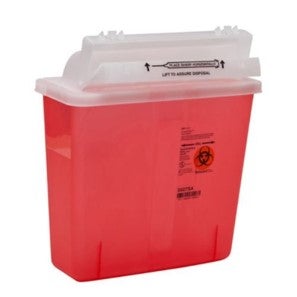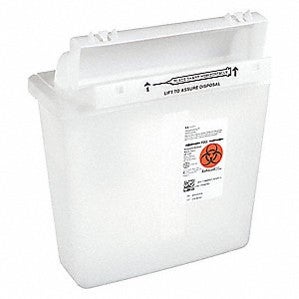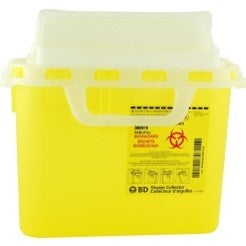Sharps
Sharps are defined as any device or object that is capable of producing lacerations or puncture injures to the skin. Sharps can include but not limited to:
- razor blades or other cutting blades
- glass (broken or unbroken)
- glass slides
- needles
- capillary tubes
In order to prevent injury to the general public, all sharps waste must be segregated into the designated waste stream and NEVER place into trash receptacles with other general trash or paper recycling receptacles.

Biologically Contaminated Sharps
Sharps used in procedures with infectious or biohazardous material are classified as regulated medical waste (RMW) and must be segregated from all other waste. All sharps waste must be placed in a rigid, plastic puncture and leak proof container with the biohazard symbol and the words "Biohazard". Needles and syringes should never be disassembled or recapped and should be disposed as one completed unit. Coverslips, glass slides and ampoules may also be placed in these containers if contaminated with infectious material. Once the sharps container is ¾ full, close and secure the container before disposing in the RMW container.
Chemically Contaminated Sharps
Sharps waste can also be generated from other laboratories such as engineering and chemistry facilities. Although these sharps do not have the biohazardous risk of exposure, all sharps must be disposed in same sharps container with the biohazard symbol marked out or covered up. Glass pipettes and TLC plates should be disposed in the broken glass container. Once the sharps container is ¾ full, close and secure the container before disposing in the broken glass container.
Radioactive Sharps
Sharps that were used for a protocol involving radioactive materials must be handled, collected, and disposed of properly depending on the types of contamination present be it radioactive, chemical, or biological.
For sharps that have radioactive contamination, use a red sharps container with "Caution Radioactive Materials" tape placed on the box. The biohazard symbol must be marked out or covered up if there is no biohazard contamination present. If multiple isotopes are used all waste including sharps must be segregated by isotope.
A protocol must be submitted to the Radiation Safety Officer before any work involving radioactive material can be performed. This protocol must include a sharps disposal procedure.


